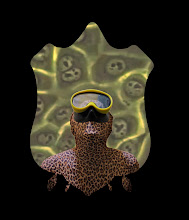
Early morning happiness...


Preparing the stain beforehand in a PC2 Lab.


Entering the AIDS Lab. BLS3 Security.

Checking out he_la cells pre-enzyme.

Washing with PBS Solution.


Staining the he_la cells with the enzyme.

Into the incubator for 2 hours.
After incubating the cells for 1 hour we checked them for visibility and the result was not very encouraging. Although we could see the blue stain very clearly in the infected cells, we could see nothing with the naked eye. Upon checking another hour later though the cells had proliferated rapidly and we could easily see the infected cells in the daylight, without the need for the microscope. Next week when we do this on the he_la cultured army guys we will extend the incubation period and hopefully the cels will proliferate more creating a stronger colour.

After 2 hours incubation the infected cells can be clearly seen in blue.


This is one of the army figurines we will be culturing he_la over and infecting with the HIV virus. Testing the possibility of viewing cells directly from the army mens bodies, but no luck...

Soldier silhouettes we will be using as acetate backdrops for animation piece.
Methodology:
The he_la cells were infected with the HIV virus two days prior to the test.
The cells were seeded in one 24 well plate.
Colouration:
Remove medium and add 1 ml of fixing solution (1% formeldehyde, 0.2% glutaraldehyde in PBS) per well for 10 mins at RT (no more than 10 min). Remove fixer and wash twice with PBS. Add staining solution (0.25 mls for 24 well plate, 0.5 ml for 12 well plate) to cells and leave at 37 degrees Celcius. Incubate the plate 2Hr (minimum, we can incubate ON at RT in the dark). The staining reaction is tsopped by washing the plates twice with PBS.
Staining solution should be fresh each time.
For 1 ml
950 microliters PBS
20 microlitres- 0.2 M, Potassium Ferrocyanide
20 microlitres- 0.2 M, Potassium Ferricyanide
10microlitres - 2 M, MgC12
10 microlitres - 40mg/ml X-Gal (make up X-Gal in DMSO and store at -20 degrees Celcius in small aliquots that are protected from the light. The X-Gal stocks will turn yellow over time. This will not affect the assay. Throw away the stocks if the yellow colour turns greenish-brown).
----------------------------------------
To see the virus's growth happen so rapidly was pretty amazing. It really hit home to me just how aggressive this organism is.
It felt really strange to be infecting Henrietta's cells with HIV. Knowing how her family feels about the mass existance of her cells, and what happenined to her makes me feel very uneasy to be using them for this purpose - but, I do feel we are using them for a positive cause, to promote issues relating to those living with HIV, and the phenomenon itself.
In the time that i've spent with her cells and her story, i've come to equate her cell with her body and thus, herself. I guess if you equate tissue with embodied existance, and you consider the massive quantities of her cell line that exist internationally, and all of the various purposes it has been used for, she is in effect a woman who has lived a thousand different lives.

No comments:
Post a Comment